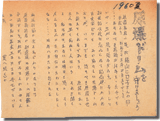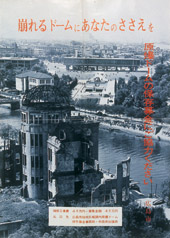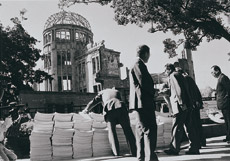 |
|
Preservation・Restoration・For Posterity
Immediately after the war, the people of Hiroshima were less interested in preserving vestiges of the horrific event than forgetting it. Caught in the argument over preservation or removal, the A-bomb Dome stood neglected for twenty years at the hypocenter.
In the 1960s, voices calling for preservation grew stronger than those calling for removal, and donations from around Japan and abroad enabled preservation construction to begin. Around this time, former residents of hypocenter neighborhoods began a hypocenter reproduction movement to clarify the damage the area had sustained. The hibakusha reproduced their own neighborhoods with their own hands to show future generations what had been and what was lost. As more residents joined in, these small efforts gradually coalesced into a large wave. In 1996, the A-bomb Dome was listed as a World Heritage site. This World Heritage standing in the city center demonstrates that the people of Hiroshima have overcome the past and have accepted their mission-sounding a warning to the future. |
||||||||||||||||||||||||||||||||||
|
||||||||||||||||||||||||||||||||||
|
||||||||||||||||||||||||||||||||||
Recreations of Lost Neighborhoods
|
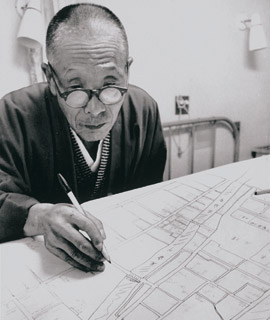 66*Hypocenter reproduction movement October 1968 Courtesy of Chugoku Shimbun When Hiroshima Central Station of NHK broadcast Camera Report- 500-meter Radius from the Hypocenter in 1966, it spawned a movement to recreate the lost neighborhoods around the hypocenter. The movement spread to the Research Institute for Radiation Biology and Medicine of Hiroshima University and to the city government. Many residents joined reproduction projects and developed the movement over the next ten years. The photo shows former residents using their memories to recapture their old neighborhoods. 68*A Map of the Hypocenter District and the Present Peace Memorial Park Courtesy of Masao Kawamura, Tsuneo Yamaga, Takuji Kimura, Ikuko Fujita, Toshie Matsuda, the Research Institute for Radiation Biology and Medicine of Hiroshima University, and NHK Hiroshima Broadcasting Station This reconstruction map of the Peace Memorial Park vicinity was completed in 2001, by adding information describing the neighborhoods that existed prior to building demolition. The major facilities in the present Peace Memorial Park are superimposed in red on the district just before the bombing shown in black. |
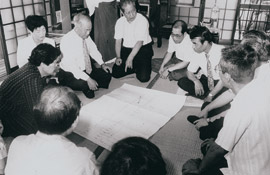 67*Recreating Kobiki-cho July 12, 1992 Jimyoin Temple Courtesy of Chugoku Shimbun The city completed its reproduction surveys in 1976, but private groups continued their projects, as if trying to fill in each vacuum. The photo shows former Kobiki-cho residents gathered to create a map of their old neighborhood. The Kobiki-cho neighborhood had stood within the boundaries of the present Peace Memorial Park. Many of its homes were being forcibly demolished for fire lanes, then the bombing wiped away all those that remained. The map was finally finished in 1995, nine years later.  |
From "Ten Feet of Film"
|
|
69*The Ten-Foot Movement
July 1980 Shinjuku, Tokyo Kinokuniya Hall Courtesy of Chugoku Shimbun A unique peace action began in 1980 when the Hiroshima Nagasaki Publishing Committee launched the Ten-Foot Movement. Each participant in the campaign contributed 3000 yen, the cost of obtaining ten feet (roughly 3 meters) of film. The group purchased roughly 85,000 feet of post-A-bomb film that had been stored in the US National Archives. The Ten-Foot Movement created a documentary film based on this footage to show around Japan. This photo shows a photo exhibition held to raise funds in Kinokuniya Hall, Tokyo. |
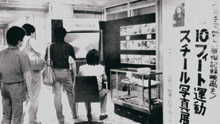  |
70*Completion of the three films
With cooperation from the people and local mass media, the Ten-Foot Movement grew rapidly. By August 1982, the people of Hiroshima had contributed 42 million yen, while donors around Japan gave 180 million yen. When the trilogy was completed, there was a wide movement to show these films in various parts of the country. |
| Rising from the Ruins -the Peace Memorial Museum and Hiroshima
1945-1954 Collecting Rubble on the Burnt Plain 1955-1974 Buildings Rising from the Ruins 1975-1990 A Place to Tell the A-bomb Story 1991 - Conveying the Spirit of Hiroshima to the World Eyes of the World Visitors to Hiroshima Museum Statistics Sixty Years for Hiroshima Preservation・Restoration・For Posterity Memories・Inheritance・Communication Conclusion Return to TOP |

